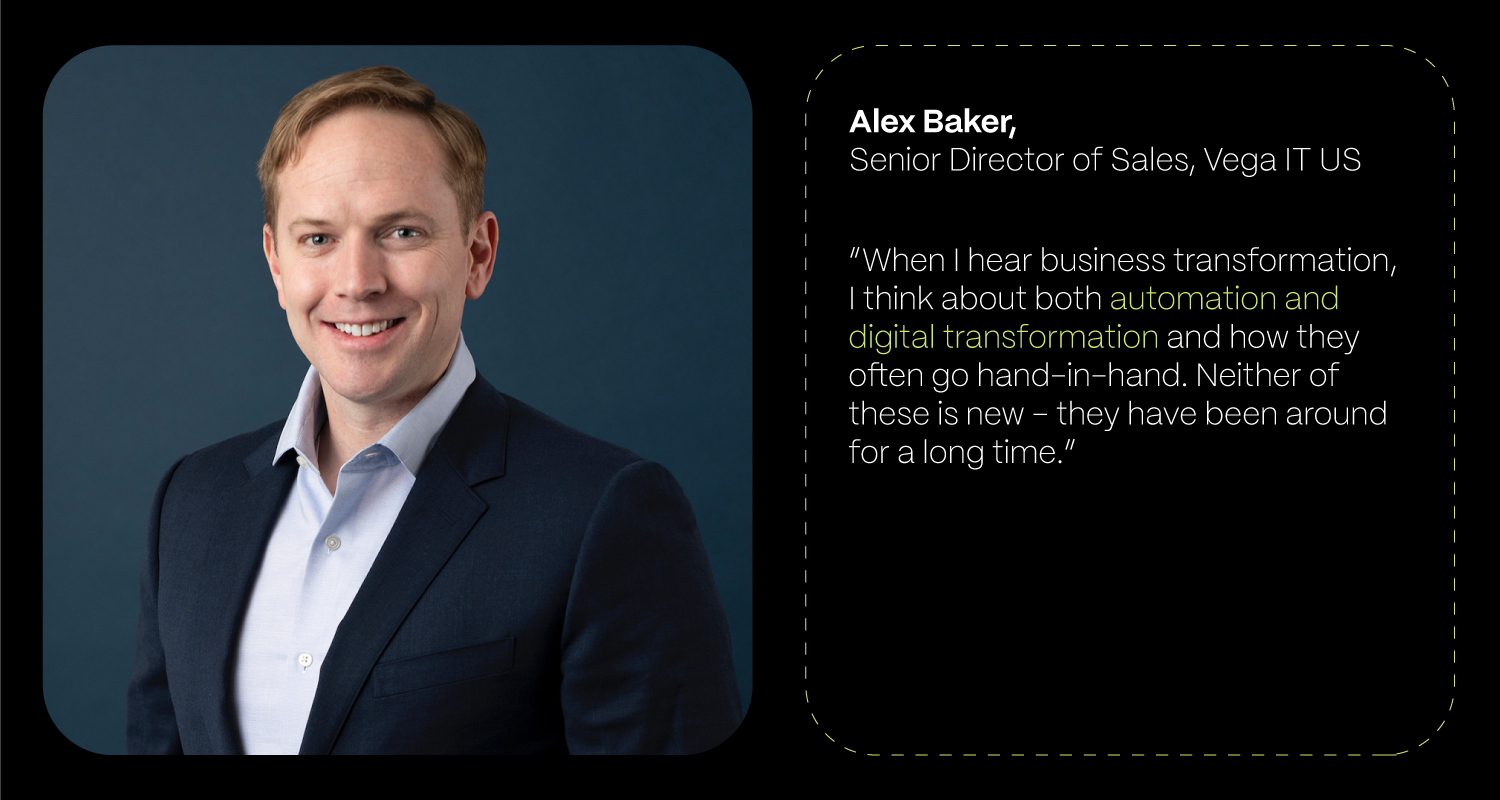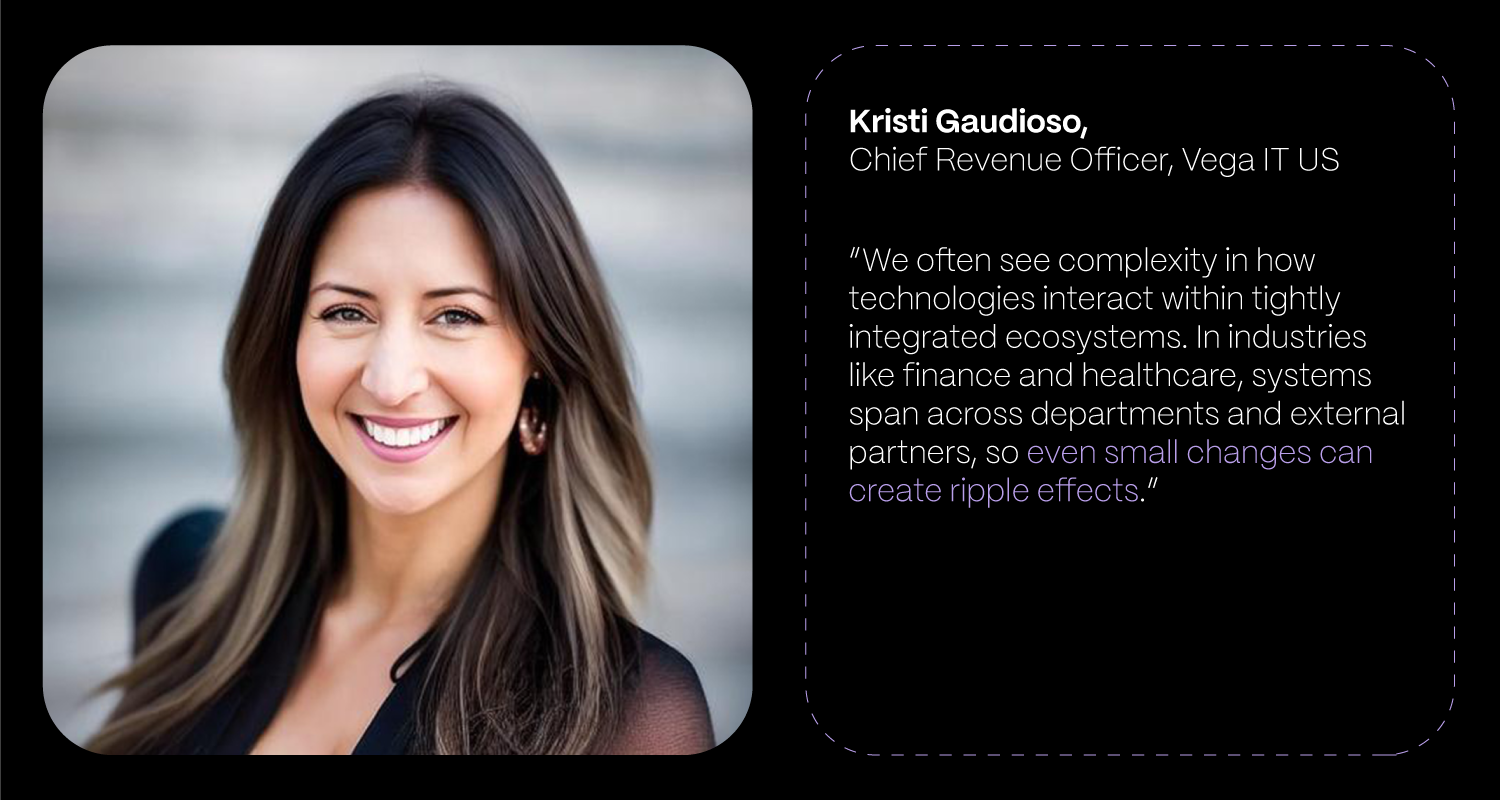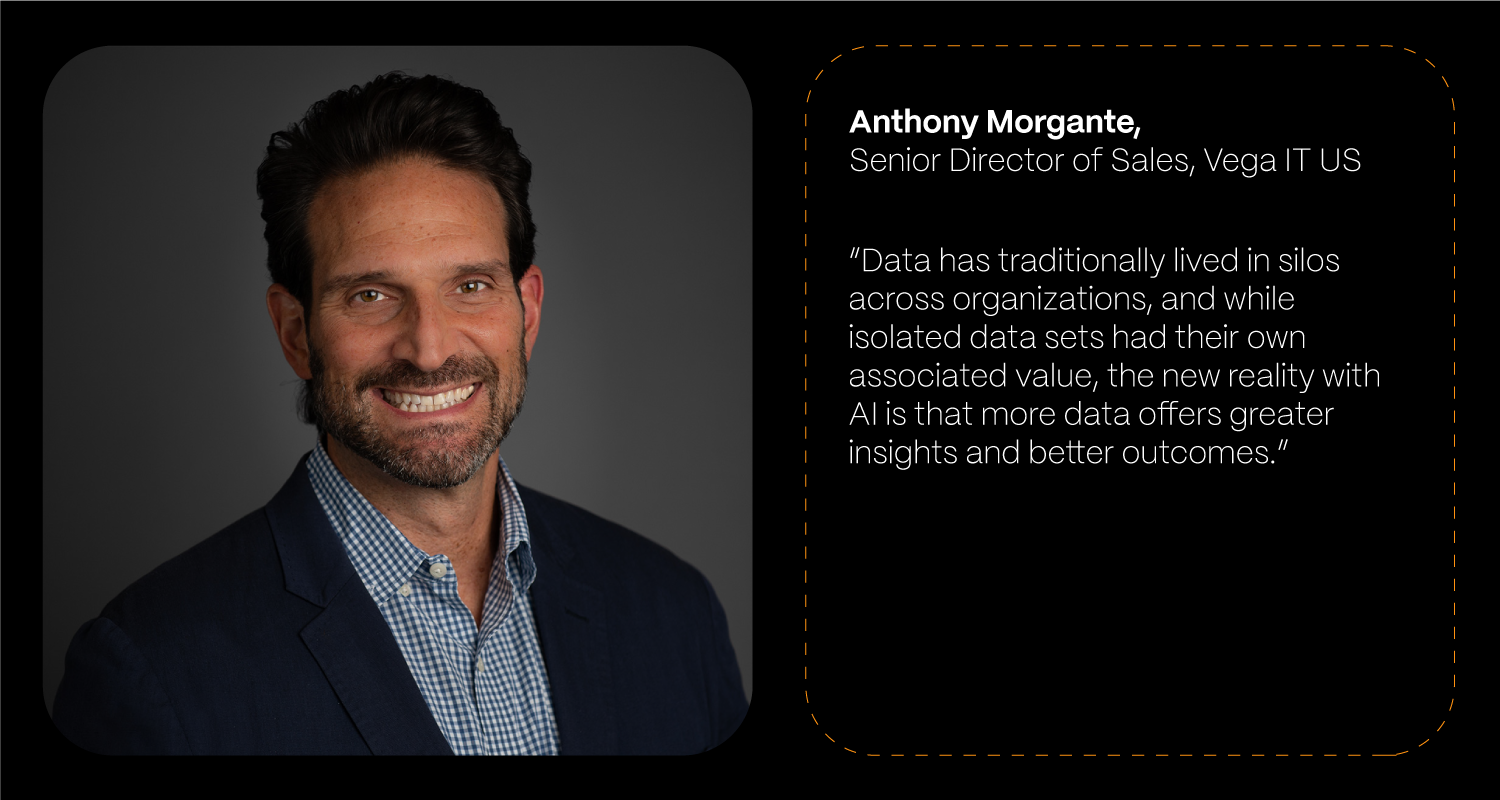Inside Vega IT’s partnership with Luminate Consulting

After opening our New York office in 2023 and continuing to support companies across the US through IT consultancy, digital transformation, and end-to-end digital product development, the next natural step for us was to strengthen our presence through the right kind of partnership.
That’s where Luminate Consulting comes in. Experts in sales strategy and revenue growth, they’ve quickly become more than just a partner. They’re an extension of our own team and a solid foundation of our US office. Together, we’re helping clients sharpen their go-to-market strategy and accelerate growth in a way that’s smart, focused, and collaborative.
In this interview, we sat down with Kristi Gaudioso (Founder and CEO of Luminate and Chief Revenue Officer at Vega IT), Alex Baker (Senior Director of Sales at Vega IT), and Anthony Morgante (Senior Director of Sales at Vega IT), to dive into how our collaboration started, why it works so well, and what happens when you bring together bright minds from both the sales and tech worlds.
We also talked about the big-picture topics shaping today’s business landscape and how companies can stay one step ahead in a constantly shifting market.
So, let’s get started.
Welcome to the team, Kristi, Alex, and Anthony.
All: Thank you!
Kristi: We’re all excited to partner with Vega IT.
Alex: Vega IT is well-positioned to grow and expand in the US, and we’re excited to be at the forefront of this initiative.
You’ve worked with some of the biggest names out there, Microsoft, Deloitte, PwC, and now you're bringing all that experience to Luminate and to Vega. Could you share a bit about your journeys?
Kristi: I started my career in the start-up space and have a passion for helping businesses grow and expand. One of the companies I worked for was acquired by Microsoft, and I spent many years there. After having the opportunity to lead sales strategy and revenue execution at many organizations, I launched Luminate to help bring that experience on a fractional basis to forward-thinking companies where we can support their expansion goals. Together, we’ve all had experiences in our careers helping organizations grow smarter – whether that’s launching into new markets, accelerating sales of new products, or reaching the right buyers more effectively.
Alex: I started my career at Deloitte Consulting and have worked for multiple software technology companies, all of which have been high-growth businesses. Most importantly, I’ve had the privilege of working with a lot of incredible people over the years.
Anthony: I started my career on Wall Street at the Federal Reserve Bank of NY where I was first exposed to many of the banking and brokerage regulations. This offered me a solid foundation when I moved to Citibank to run one of their largest US data centers. My subsequent roles at Ernst & Young as a global IT project manager allowed me to mature my delivery acumen across technology platforms and solutions, which then helped fuel my technology sales career that followed at Microsoft, AWS and PWC. These great companies have given me great exposure to some of the most complex scenarios that only tech can solve. An important lesson however is that technology solutions, no matter how advanced, still need humans to get it right.
As sales and strategy professionals, you’ve worked with organizations across industries that are actively investing in digital transformation. In your experience, what common patterns emerge when these companies try to implement new technologies?
Alex: When I hear business transformation, I think about both automation and digital transformation and how they often go hand-in-hand. Neither of these is new – they have been around for a long time.
However, the products and technologies that are best utilized to pull off these transformations have changed significantly. These projects are becoming more and more advanced. In fact, it’s these exponential technologies that make it just so difficult for business leaders even with their vast knowledge and expertise, to comprehend the speed at which these technologies are constantly evolving right now.
Anthony: However an organization defines business transformation, the three common stumbling blocks are:
1. having the right amount and level of skills needed to execute (in-house or external);
2. having a clear data strategy to enable the transformation;
3. having a change management plan to update, retire, and implement new process changes as a result.
For example, every company has a desire to leverage AI to increase efficiency. However, success with AI depends on clean, high-quality, consistent, dependable data that has the proper access and security controls in place. Failure to invest in a comprehensive data strategy will make for a long, expensive, and often disappointing AI journey.
Kristi: Exactly, Anthony. Across industries, we consistently see that transformation efforts tend to stall not because of the technology itself, but because of how it is implemented and integrated into the broader organization. Many companies are resource-constrained and siloed, making it difficult to execute at speed.
Industries like insurance, finance, and healthcare are under growing pressure to modernize, whether through AI, automation, or improved customer experiences. Yet progress is often slower than expected. From your experience, what are the underlying factors that make digital transformation especially difficult in these highly regulated, risk-sensitive sectors?
Anthony: The financial services and insurance sectors specifically are made up of many large, mature institutions that have traditional high-transaction, high-touch manual processes. Many of them have accumulated mountains of data.
While many have made investments in application modernization and have adopted digitalization when it comes to paperwork, a very high percentage still have technical debt locked up in legacy systems and platforms like mainframes. The data contained within those legacy systems pushes these organizations that much farther away from being able to leverage the innovation in AI.
The pace of modernizing off of these legacy systems remains slow because it is always a heavy lift. Many mainframes have 10s of millions of lines of code, much of which is undocumented accompanied by 100,000+ business rules. There are also huge capital investments made to date on these critical legacy systems, and so banks and the like are sometimes reluctant to sunset due to the heavy investment and long-term ROI.
Kristi: In addition to the legacy systems challenge that Anthony highlights, we often see complexity in how technologies interact within tightly integrated ecosystems. In industries like finance and healthcare, systems span across departments and external partners, so even small changes can create ripple effects.
Regulatory requirements add another layer of difficulty, requiring that every solution supports auditability, security, and compliance from day one. Transformation in these sectors succeeds when modernization efforts are grounded in a clear understanding of industry-specific workflows and constraints. Without that, progress tends to slow or stall.
Alex: Keep in mind that industries like insurance, financial services & banking, and healthcare and pharma, are not unique in the challenges they are facing. However, they certainly require more thoughtful approaches and solutions to solve these issues. Oftentimes, the solutions in other industries can be adopted and customized to these highly regulated industries to be successful.
There’s so much talk about AI capabilities, but many companies fail to implement them successfully into their workflows. What typically prevents them from turning AI into a lasting competitive advantage?
Kristi: We often see a gap between building AI solutions and integrating them into operational workflows in a way that delivers sustained value. Many organizations develop promising models, but without a clear plan for how those models fit into day-to-day processes, adoption and impact are limited. One approach we have seen work well in highly regulated or complex environments is using a digital twin.
It allows teams to simulate real-world conditions, test AI outputs safely, and refine integration points before going live. This helps build confidence in the system, align cross-functional teams, and ensure that AI becomes a trusted part of how the organization operates. Making AI usable at scale is less about the algorithm and more about thoughtful design, systems integration, and execution.
Anthony: Exactly, Kristi. A lack of data governance and poor quality data are usually the biggest stumbling blocks for AI projects. The reason for that is simple – data has traditionally lived in silos across organizations, and while isolated data sets had their own associated value, the new reality with AI is that more data offers greater insights and better outcomes. Democratizing data access for everyone in the company with the appropriate guardrails, ownership and accountability of the data by stewards close to the data brings access to everyone while keeping data quality and security high. Organizations that fail to update their data strategy/governance will continue to struggle with AI going forward.
Outside of those pitfalls, inappropriate scope and vague use cases are probably more at fault for AI project failures. Regardless of the size of the organization, starting with small projects, each having a well-defined scope and success criteria, is very critical.
Quick wins (and failures), clear value and efficiencies gained, and measured investment will not only lead to more successes but also establish confidence in AI throughout all levels of the organization.
Alex: In addition to what has already been said, we should always keep in mind that data governance can be extremely complicated, especially in highly regulated industries. It may be necessary to hire a third-party expert in that area to help the company understand the regulatory complexities and navigate the nuances that are required. In other instances, it can be as simple as detailing out each requirement for the type or category of data and matching up the necessary solution.
So, in short, what usually prevents businesses from successfully implementing AI is a lack of understanding of the use case for an AI tool or application. Once these factors are aligned, then the solution becomes much more apparent and tangible to create and implement.
That sounds like a lot for any company to navigate. How do you typically help clients make sense of it all and start developing a strategy that really works for them?
Anthony: How do you eat an elephant? One bite at a time, and invite your friends. At Vega IT, a big part of how we help clients develop an enterprise data strategy and then focus on developing the proper use cases for AI starts with top-down alignment from leadership, followed by in-depth exploration, strategic advisory through industry expertise and precision delivery by our deep specialists and data scientists.
We’re familiar with the challenges our clients face and have a better ability to see around corners and setting proper expectations based on our industry experience. AI solutions are so very new and continue to innovate at such a rapid rate that it is safe to say that most, if not all, organizations need assistance to “get it right.”
Kristi: We typically begin by helping clients take a step back to understand the landscape more clearly. That includes identifying the outcomes they are aiming for, recognizing where current limitations exist, and assessing what strengths they already have in place. From there, we collaborate to build a practical, phased strategy that aligns with both technical realities and business priorities. A big part of our role is helping teams move from broad concepts to focused, manageable steps. The goal is to create progress that is sustainable and thoughtful, not rushed, so the changes being made are set up to deliver long-term impact.
And, what does kicking things off usually look like? How do you help them get from complexity to clarity?
Alex: We typically meet clients where they are in their AI journey. That may mean a strategy workshop, or stakeholder interviews, or even a full end-to-end product development cycle, where we either lead it or work alongside the client until we reach their objective.
Anthony: That’s right, Alex. The most effective way to kick off an AI journey with a client is to have an initial workshop for both Vega IT and the decision makers at the client to align on business and technical priorities, timeframe, needs and capabilities, and most importantly, challenges. This would be followed by a series of smaller workshops during the discovery phase. The outcomes from these workshops would lead us towards solving with a lens of business outcomes. Those business outcomes would then translate into business and cost justifications and ultimately a delivery timeline that everyone feels comfortable with from an execution and ROI standpoint.
Finally, can you share with us what inspired you to partner with Vega IT in the first place?
Kristi: In our line of work, we meet many capable teams, but it is rare to find one that combines deep technical skill with strong business acumen. Vega IT brings both. Vega IT is strategic in how it approaches each client, yet also highly technical, with teams that are continuously learning, pursuing new certifications, and staying current with emerging technologies.
Just as importantly, we share a cultural alignment as Vega IT leads with a customer-first mindset, values adaptability, and takes pride in doing great work. As we help expand the business in the US, we’re focused on supporting customers in solving critical challenges, managing costs, reducing time to market, and accelerating long-term success.
We saw an opportunity to complement that with our US go-to-market experience, bringing together a strong foundation of delivery with a thoughtful approach to client engagement, market entry, and revenue growth.
Alex: We have been impressed with the people, expertise, and openness to explore and create new solutions together. Vega IT is a great company with a lot of experience and nearly a thousand incredibly smart, hard-working professionals who are great technical assets to any company.
Anthony: Vega IT is a great brand in Europe and the Middle East. They’ve established a strong reputation for quality work, high-integrity people, and smart engineers. We feel Vega IT can offer great value to so many US organizations in need of the many deep skills found at Vega IT around data, AI/ML, digital product development and application modernization.
In the upcoming years, how do you see Vega IT making an impact in the US region and providing value to clients?
Alex: Over the years to come, we’d love to see Vega IT go from an upstart new arrival in the region to a leader and eventually become a household name. We believe all of the right pieces and resources are in place for this to become a reality with the meaningful collaboration of our team members, clients, and partners in the US.
Anthony: When I was the NA Partner Sales Leader at AWS, we had a customary activity where we would help clients see our joint vision of success by writing a press release about them that would take place in the future. In Vega IT’s case, I see the title of the press release being “Vega IT tops America’s Fastest Growing Company list with a 155% CAGR.”
Kristi: Each year, we see companies face increasing pressure to do more with less. Budgets are tighter, timelines are more aggressive, and internal teams are expected to deliver complex initiatives while also managing daily operations. In this environment, the ability to bring in high-quality external talent to complement internal teams, launch end-to-end projects, and accelerate key initiatives can be a significant advantage.
Vega IT is well-positioned to meet those needs. It combines strong engineering capabilities with a strategic mindset and know-how to work within complex organizations. Whether a company is launching a new product, modernizing its technology stack, or trying to accelerate delivery, Vega IT brings the structure, skill, and adaptability to move initiatives forward efficiently and effectively. We’re excited to be a part of Vega’s growth and long-term success!
We’re only at the beginning of our journey with Luminate Consulting, but the potential already feels exciting. At Vega IT, we’re proud to take this step together and genuinely look forward to what lies ahead. Here’s to growing smarter, faster, and stronger. Side by side, every step of the way.
Give our rapid digital twin prototyping a try and preview your software before a single line of code. Free for the first five who act.






